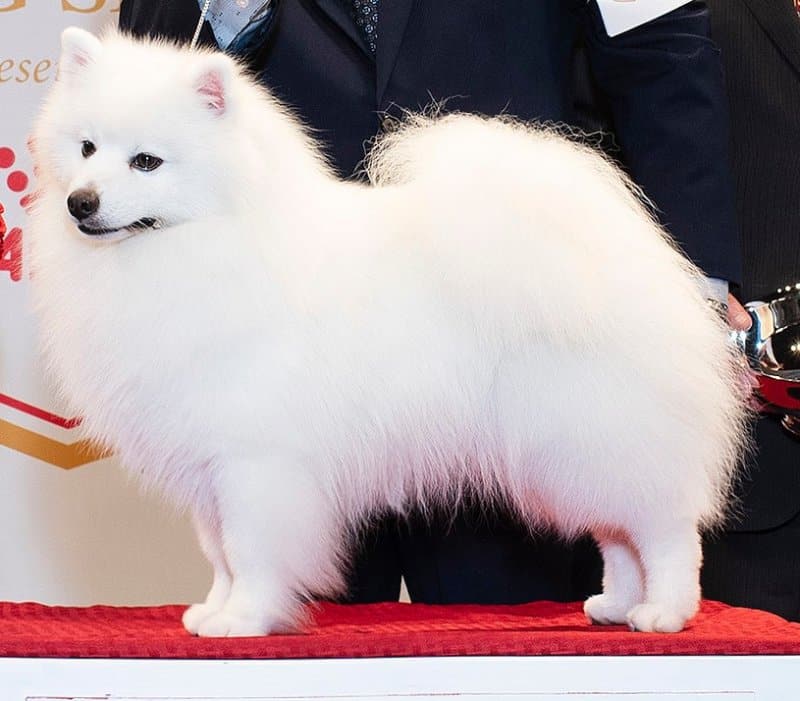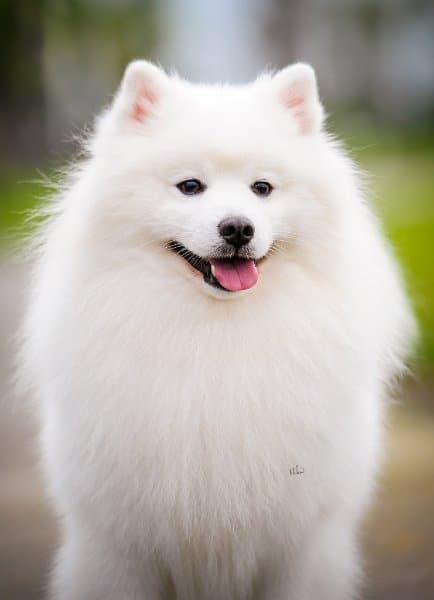
Home » Judging the American Eskimo Dog

The American Eskimo Dog (AED or Eskie) was fully recognized by the American Kennel Club on July 1, 1995. Since then, judges have come to appreciate our breed. Overall, I find that most judges do a very nice job of evaluating our dogs, even giving the young American Eskimo Dogs a little extra time to learn about the show ring. Thank you to those judges!
In the almost 30 years since full recognition, many new judges have been approved for the American Eskimo Dog. This article is aimed at new and aspiring judges, to perhaps help them understand the nuances of our Breed Standard. Our Toy Eskies are not over-sized Pomeranians, and our Standard Eskies are not miniaturized Samoyeds. We do not use the words “bear” or “fox” in our Breed Standard, although many fanciers use those words when describing Eskies.
A brief description of the American Eskimo Dog is summarized in the “General Appearance” paragraph in the AKC Breed Standard, which begins:
“The American Eskimo Dog, a loving companion dog, presents a picture of strength and agility, alertness and beauty. It is a small to medium-size Nordic type dog, always white, or white with biscuit cream. The American Eskimo Dog is compactly built and well balanced, with good substance, and an alert, smooth gait. The face is Nordic type with erect triangular shaped ears, and distinctive black points (lips, nose, and eye rims).”
SHOWSIGHT has requested that I explain a few terms used in the Breed Standard, such as “Nordic type dog,” “distinctive black points,” and “learns new tasks quickly.”

The American Eskimo Dog, a loving companion dog, presents a picture of strength and agility, alertness and beauty.
While the word “Nordic” technically applies to things and animals associated with Scandinavia, the term is also used to describe dogs developed in the far northern latitudes of Europe, North America, and Asia. This includes dogs ranging in size from the Pomeranian to the Alaskan Malamute, and includes the American Eskimo Dog.
The term “distinctive black points” can be confusing to some people. It has been used by Eskie fanciers since the 1970s, often when describing the coat color: “white with black points.” When used to describe coat color, this usage actually means that the coat is white with black points—feet, tail, and ear tips—similar to the color of a Siamese cat. This is NOT the intended definition in the Breed Standard.
The Breed Standard clearly states in the General Appearance paragraph that “black points” refer to the nose, lips, and eye rim pigment. However, when reading further in the Breed Standard, judges are told that either black or dark brown pigment is a permitted pigment color, with no preference for either.
In young dogs, both black pigment and dark brown pigment appear virtually identical, especially in the lighting found in many indoor buildings where dog shows are held. As the dogs age, the dark brown pigment begins to turn a liver color, sometimes referred to as “snow nose.” Eskies with black pigment will typically get a blue-black, almost charcoal, patina on their noses.
Some owners and handlers solve this pigment “problem” by dying their Eskies’ noses black. As judges, we can’t always tell which dog has had its nose dyed, unless the dog licks the pigment before it’s dry and gets the black pigment on its tongue.
I always tell new judges that if you are concerned about pigment on an Eskie’s nose, look to its eyes and lips because they do not fade as noses do. If the eye rims and lips are dark, then it has correct pigment.
In describing the Eskie’s head, listed faults include pink eye pigment, pink nose pigment, and pink lip pigment. I tell judges that pink pigment is PINK, like a pink rose. Again, look to the eye rims and lips to understand what the Eskie’s true pigment is.
The Eskie was developed through the American circus and is a highly intelligent, easily-trained dog. Obviously, during the 2-1/2 minutes a judge has to evaluate an American Eskimo Dog, it will not learn a new trick for you.
But the Eskie’s intelligence should be obvious during your examination, and the Head paragraph in the Breed Standard describes the Eskie expression as “keen, intelligent, and alert.” They are often looking all around to see that all is going as it should.
Young Eskies may be nervous if they have not been shown often. I tell judges that it is better to allow American Eskimo Dogs to go around the ring before examining them on the table, especially in a single-entry class. Eskies really want to see what’s going on ringside and will often behave better on the exam table if allowed to “go around” first. Judges must see side movement in their evaluation!
The Breed Standard describes the correct Eskie coat as:
“The American Eskimo Dog has a stand-off, double coat consisting of a dense undercoat and a longer coat of guard hair growing through it to form the outer coat. It is straight with no curl or wave. There is a pronounced ruff around the neck which is more noticeable on dogs than bitches. Outer part of the ear should be well covered with short, smooth hair, with longer tufts of hair growing in front of ear openings. Hair on muzzle should be short and smooth. The backs of the front legs should be well feathered, as are the rear legs down to the hock. The tail is covered profusely with long hair.”
Typically, bitches carry less coat than dogs, so please do not penalize the girls because they don’t carry the full coats that the dogs do.
The Breed Standard is silent as to coat texture. Some judges have asked which texture is correct—a soft texture or the harsher texture? My answer is: As long as the coat is a stand-off, double coat and weather-resistant (think of the Arctic), the coat is correct.
The Breed Standard states:
“Pure white is the preferred color, although white with biscuit cream is permissible. Presence of biscuit cream should not outweigh consideration of type, structure, or temperament.”
As a breeder-judge, I interpret this description to mean that white is preferred, although white with biscuit cream (a very light tan) is permitted. You should have the impression of a white dog.
I have noticed through the years that dogs often carry more biscuit cream than bitches, probably because they do not go through the continual cycle of blowing coat as bitches do with their seasons. The biscuit cream is usually on the guard hair and results from exposure to sunlight. When I examine the coat of an Eskie with biscuit cream, I look for a change in the color from biscuit cream to white on the hair shaft, about halfway down. If I see the change, then I can more easily forgive the presence of biscuit cream.
But please remember that any color other than white or white with biscuit cream is a disqualification.
Pure white is the preferred color, although white with biscuit cream is permissible. Presence of biscuit cream should not outweigh consideration of type, structure, or temperament
This problem is especially concerning to me as a breeder-judge. The Breed Standard requires that the “backs of the front legs should be well feathered, as are the rear legs down to the hock.” It further states: “There is to be no trimming of the whiskers or body coat and such trimming will be severely penalized. The only permissible trimming is to neaten the feet and the backs of the rear pasterns.”
In the past few years, I have noticed several of the top-ranked specials having the backs of their rear legs above the hock being severely trimmed, as is typical in the Chow Chow and Pomeranian rings, so that judges can see the rear angulation. THIS IS NOT CORRECT! The American Eskimo Dog is a natural breed, and the only trimming permitted in the Breed Standard is to neaten the feet and the backs of the rear pasterns.
While I have seen many judges penalize trimmed American Eskimo Dogs, too many judges are rewarding this grooming trend by giving trimmed Eskies top placements, whether in the Breed or Group rings. As long as judges reward this behavior, it will continue to be a problem. The crazy thing is that such Eskies have a profuse coat everywhere except for their trimmed rear legs!
The no-trim requirement applies to the inside of the ears and to the whiskers. I haven’t seen an Eskie in many years with the hair trimmed out from inside its ears, but I have seen many specials in the ring today with trimmed whiskers. The top Eskie handlers know that trimming whiskers is NOT allowed.
The Breed Standard states:
“Tear stain, unless severe, is not to be faulted. Presence of tear stain should not outweigh consideration of type, structure, or temperament.”
No one likes tear stain, but I discovered after moving to Arizona that the dust in the air causes my formerly clean Eskie faces to have tear stain. I work to keep it under control, but dust and pollen blow in the desert wind.
Please remember that the presence of tear stain is not to be faulted unless “severe,” which means (to me) that the stain is on both the upper and lower lids and is not confined to the inside corners of the eyes. An Eskie which has correct size, structure, and temperament, who also has tear stain, is a better example of the breed than a mediocre Eskie with a clean face.
In closing, thank you for your interest in the American Eskimo Dog. I look forward to seeing everyone in the show ring.
Showsight Magazine is the only publication to offer dedicated Digital Breed Magazines for ALL recognized AKC Breeds.
Read and learn more about the American Eskimo Dog breed with articles and information in our American Eskimo Dog Breed Magazine.
Error embedding FlippingBook shortcode, please check the flipbook url. (https://digital.showsightmagazine.com/view/987571/)
If you enjoy the American Eskimo Dog Breed Magazine, help us educate the community by sharing it.